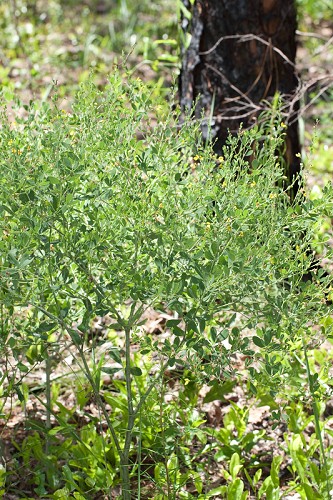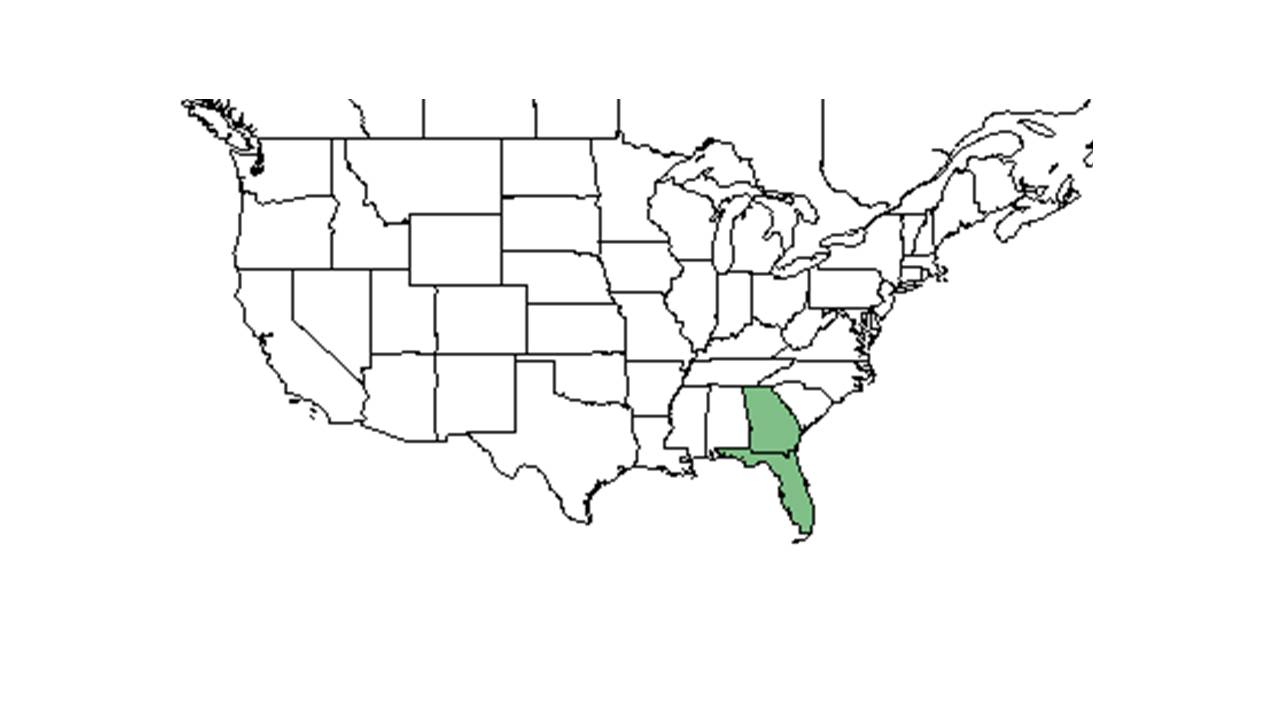Difference between revisions of "Baptisia lecontei"
KatieMccoy (talk | contribs) (→Description) |
KatieMccoy (talk | contribs) |
||
| Line 27: | Line 27: | ||
==Ecology== | ==Ecology== | ||
===Habitat=== <!--Natural communities, human disturbed habitats, topography, hydrology, soils, light, fire regime requirements for removal of competition, etc.--> | ===Habitat=== <!--Natural communities, human disturbed habitats, topography, hydrology, soils, light, fire regime requirements for removal of competition, etc.--> | ||
| − | ''B. lecontei'' requires open areas and strong, consistent winds for seed dispersal.<ref name="Mehlman 1993"/> It also prefers higher light levels and moist to dry sandy soils like loamy sand and loose sand | + | ''B. lecontei'' requires open areas and strong, consistent winds for seed dispersal.<ref name="Mehlman 1993"/> It also prefers higher light levels and moist to dry sandy soils like loamy sand and loose sand. It is found in longleaf pine-oak sandhill communities, shrub oak ridges, and pine flatwoods. However, it can also be found in certain disturbed habitats such as power line corridors, roadsides, railways, and cleared areas<ref name="fsu"/>. |
| − | Associated species include ''Pinus palutris, Cuthbertia rosea, Quercus laevis, Q. marilandica, Q. geminata, Q. falcata, Q. incana, Prunus serotina, P. umbellata, Disopyros virginiana, RHus copallina, Vaccinium arboreum, V. stamineum, Rubus cunefolius,'' and others | + | Associated species include ''Pinus palutris, Cuthbertia rosea, Quercus laevis, Q. marilandica, Q. geminata, Q. falcata, Q. incana, Prunus serotina, P. umbellata, Disopyros virginiana, RHus copallina, Vaccinium arboreum, V. stamineum, Rubus cunefolius,'' and others<ref name="fsu"/>. |
===Phenology=== <!--Timing off flowering, fruiting, seed dispersal, and environmental triggers. Cite PanFlora website if appropriate: http://www.gilnelson.com/PanFlora/ --> | ===Phenology=== <!--Timing off flowering, fruiting, seed dispersal, and environmental triggers. Cite PanFlora website if appropriate: http://www.gilnelson.com/PanFlora/ --> | ||
Revision as of 14:31, 4 April 2016
| Baptisia lecontei | |
|---|---|

| |
| Photo by John R. Gwaltney, Southeastern Flora.com | |
| Scientific classification | |
| Kingdom: | Plantae |
| Division: | Magnoliophyta - Flowering plants |
| Class: | Magnoliopsida - Dicotyledons |
| Order: | Fabales |
| Family: | Fabaceae ⁄ Leguminosae |
| Genus: | Baptisia |
| Species: | B. lecontei |
| Binomial name | |
| Baptisia lecontei Torr. & A. Gray | |

| |
| Natural range of Baptisia lecontei from USDA NRCS Plants Database. | |
Common Name: pineland wild indigo
Contents
Taxonomic notes
Description
Baptisia lecontei is a bushy herb from a solitary stem, with knotty roots[1].
Distribution
Ecology
Habitat
B. lecontei requires open areas and strong, consistent winds for seed dispersal.[2] It also prefers higher light levels and moist to dry sandy soils like loamy sand and loose sand. It is found in longleaf pine-oak sandhill communities, shrub oak ridges, and pine flatwoods. However, it can also be found in certain disturbed habitats such as power line corridors, roadsides, railways, and cleared areas[1].
Associated species include Pinus palutris, Cuthbertia rosea, Quercus laevis, Q. marilandica, Q. geminata, Q. falcata, Q. incana, Prunus serotina, P. umbellata, Disopyros virginiana, RHus copallina, Vaccinium arboreum, V. stamineum, Rubus cunefolius, and others[1].
Phenology
This species has been observed flowering from April through July, and fruiting from June through August (FSU Herbarium).
Seed dispersal
Baptisia lecontei uses tumbleweed dispersal, a type of long-distance dispersal mechanism by which means the whole or a part of the plant serves to disperse seeds by being blown into the wind.[3] Mehlman observe that B. lecontei could be found over 50 meters away from where it originated, evidently by wind dispersal [2]
Conservation and Management
Cultivation and restoration
Photo Gallery
References and notes
Florida State University Robert K. Godfrey Herbarium database. URL: http://herbarium.bio.fsu.edu. Last accessed: June 2014. Collectors: Loran C. Anderson, R.K. Godfrey, Richard D. Houk, John K. Small, George R. Cooley, Leonard J. Brass, Robert Kral, Mabel Kral, Walter S. Judd, Paul Kalaz, Steve L. Orzell, Edwin L. Bridges, S. W. Leonard, Allen G. Shuey, A. H. Curtiss, Grady W. Reinert, W. Wilson Baker, Richard D. Houk, and A. F. Clewell. States and Counties: Florida: Wakulla, Suwannee, Clay, Columbia, Bay, Gilchrist, Leon, Hernando, Marion, Franklin, Lake, De Soto, Duval, and Dixie. Georgia: Brantley, Brooks, Lowndes, and Lanier.
- ↑ 1.0 1.1 1.2 Florida State University Robert K. Godfrey Herbarium database. URL: http://herbarium.bio.fsu.edu. Last accessed: June 2014. Collectors: Loran C. Anderson, R.K. Godfrey, Richard D. Houk, John K. Small, George R. Cooley, Leonard J. Brass, Robert Kral, Mabel Kral, Walter S. Judd, Paul Kalaz, Steve L. Orzell, Edwin L. Bridges, S. W. Leonard, Allen G. Shuey, A. H. Curtiss, Grady W. Reinert, W. Wilson Baker, Richard D. Houk, and A. F. Clewell. States and Counties: Florida: Wakulla, Suwannee, Clay, Columbia, Bay, Gilchrist, Leon, Hernando, Marion, Franklin, Lake, De Soto, Duval, and Dixie. Georgia: Brantley, Brooks, Lowndes, and Lanier.
- ↑ 2.0 2.1 Mehlman, D. (1993). "Tumbleweed dispersal in Florida sandhill Baptisia (Fabaceae)." Bulletin of the Torrey Botanical Club 120: 60-63.
- ↑ Pijl 1972 cited by Mehlman 1993, more citation needed.